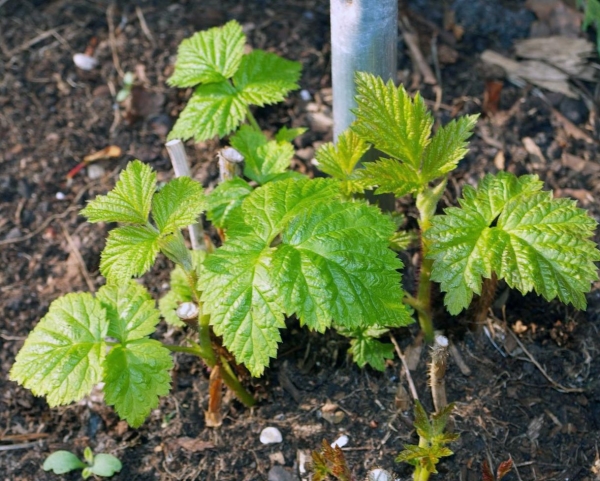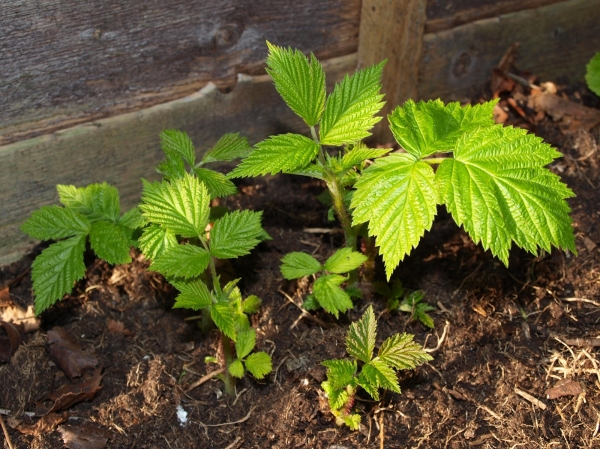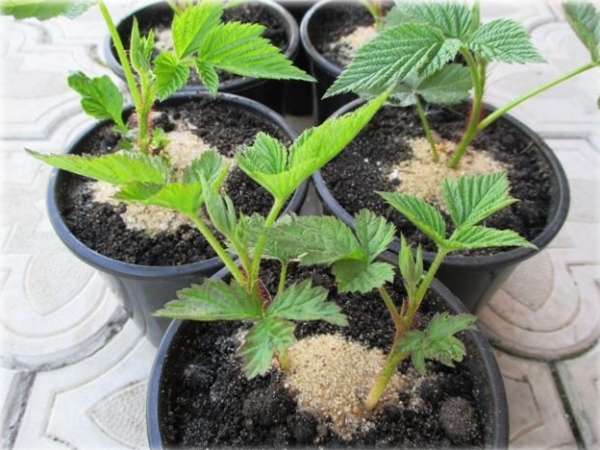Raspberry - shrub. Replacement shoots are laid on the rhizomes - next to a two-year-old stem or root shoots - in a new section that has grown this year.
In the first summer, only leaves are formed on the stems (on the remontant varieties - also flowers, but this is an exception inherent to the remontant varieties) and buds are laid.
On the second, fruiting twigs are formed from the buds, after which the stem dies off. Three-year stalks of raspberry does not happen.
Table of contents
Raspberry breeding
How to breed root suckers
The culture is spreading over the area by the growth of rhizomefrom which new stems grow.
This will be the planting material., moreover, the raspberry has a high degree of regeneration, root offsprings are planted immediately to a new place.
Survival rate is excellent. It is more convenient to replant in the fallafter the end of the growing season. However, this method (as an exception) can be propagated at any time of the year. Better in cloudy or rainy weather: in the heat of the seedlings will dry up.
The transfer with a lump of land, on time, with irrigation and in good (or rather, bad: rainy, cool, overcast) weather gives almost 100% survival.

Breeding root cuttings
Procurement of cuttings is carried out at the same time with the liquidation of a plantation, digging of root suckers or specially.
Pieces of rhizome with a thickness of more than 2 mm (this is a minimum, better than more than 5 mm) and 10–15 cm long are neatly tied in bunches and placed in a shallow trench for wintering.
Fallen leaves or other material are poured on top, it should not be allowed to freeze. The best storage temperature is 0 +4 С.
Can be stored not in a trench, but in a cold cellar, preferably - covered with sand, earth, leaves. Do not overdry or freeze.
Planted in the spring, in a trench up to 10 cm deep, as soon as possible. Spread flat. From above, it is desirable to cover with a film to warm the soil and retain moisture. Do not forget to water.
When green shoots appear, the film is removed. The survival rate in practice for most varieties is 60–80%.

Green cuttings (cutting)
Cut stems with shears, deepening it a few centimeters into the ground (do not forget to clean the tool field of work). Then cut into cuttings 5-7 cm.
Some cutting is done in water. It is inconvenient, but the idea is good: at the same time, the juice-carrying bundles are not clogged at the cut point by air. The same is done with bouquets of roses, if they want it to stand longer: they update the cut under water.
You can simply cut at a right angle, you can make the lower cut oblique, the top - straight. On an oblique cut, the roots grow better, and the straight has a minimum area - there is no excess evaporation.
The cuttings are put into a solution of a growth regulator — heteroauxin, indolyl butyric acid, growth powder, and root. Exposure - according to the instructions for the drug.
You may be interested in these materials:
Preparation of the solution is the same: usually drugs are sold unprepared for use, and there are some that need to be diluted first in alcohol, only then in water.
Prepared cuttings are planted for rooting in a greenhouse or greenhouse with a fogging installation. The main reason for poor survival is drying out. Therefore, it is desirable to keep the relative humidity under 100%.
If there is no greenhouse, cover the cuttings with glass or film. In the country, if you need a little seedlings, you can cover with glass jars or cut plastic bottles.
Sheet plate is preferably half cutThis will reduce the evaporation of moisture.In any case, the soil during the rooting period should not dry out!
Not earlier than a month after planting, the graft roots can be transplanted to a place of constant growth. With all the care, with a lump of earth, in suitable weather.

How to propagate by dividing the bush
On practice the method is applied to varieties that give little root suckers. For example, to Rubin Bulgarian. Or when transplanting very valuable varieties or hybrids.
The survival rate is excellent, but the multiplication factor is small., large labor costs with a small number of bushes received.
The essence of the method is clear from the name: a dug raspberry bush is divided into several parts, each is planted separately. Conducted in the fall - after the end of the growing season or in the spring - before the start of sap flow.
How to raspberry seed
The fruit of the raspberry is a collective drupe, and seeds are quite suitable as planting material. But more labor is required, and the result is unpredictable: the characteristics of the variety (hybrid) are not preserved. In another way: it is impossible to get seedlings of the original variety from the farms.
Propagation by seeds is practiced only during selection work., but since geneticists do not need to search for information in popular articles, it is not worth detailing seed reproduction here.
Rooting tops
The method consists in bending down and dropping top of the stem. You can additionally pin, so as not to rise, Y-shaped wand. Accelerates the formation of roots a small pruning before the kidney.
Firstly, they multiply in this way better than the usual raspberries. Secondly, by cutting them to multiply worse, thrown out much more often. For example, the output of cuttings of the variety Logangeberry is about 10%.
Little tricks
Raspberry feature: if you cut and remove the base, central fraction of the bush, the remaining part forms a lot of root shoots. The same - with a strong pruning.
This can be used if the goal is to get a lot of planting material, and not to harvest a large crop of berries this year.

Features of planting seedlings in autumn and spring
As with any planting (sowing) of perennial culture, it is better to fill the soil with fertilizers before planting. Bringing them into bare land is technically easier than growing a plantation.
It is clear that in subsequent years it will be necessary to add nutrients, but it is advisable to add a significant part, especially organic matter, when laying the plantation.
Raspberry does not like chlorinetherefore, the introduction of chlorine-free forms of potash fertilizers is desirable. If there is no choice, then chlorine-containing fertilizers are applied in the fall.
The peculiarity of the CCP (soil absorption complex) is that it keeps chlorine poorly, and part of the element will leave the soil during the winter without causing damage to the bushes. The same applies not only to raspberries, but also to all other crops.
And most importantly, it protects the small root hairs from drying out, ultimately improving the survival rate. The effect is increased if the seedlings are waiting for a long transportation or storage.
Planting raspberry root suckers:
The breeding method each chooses at its discretion.you should not argue with fanatics of this or that method. But such a culture as raspberries is perfectly divorced by rhizomes.
In practice, you should not suffer and cut the stems, it is easier to use pieces of rhizome, already with sprouted stems or without them.
Root offsprings or root cuttings are easily harvested and perfectly take root.This is a feature of raspberry. The remaining methods - for special conditions or varieties.
